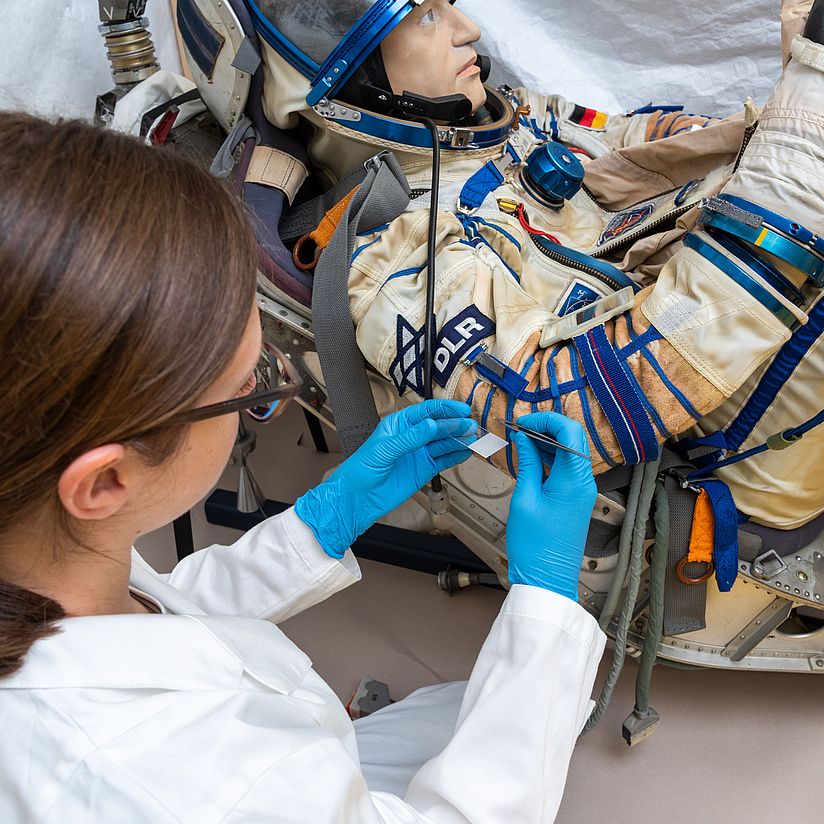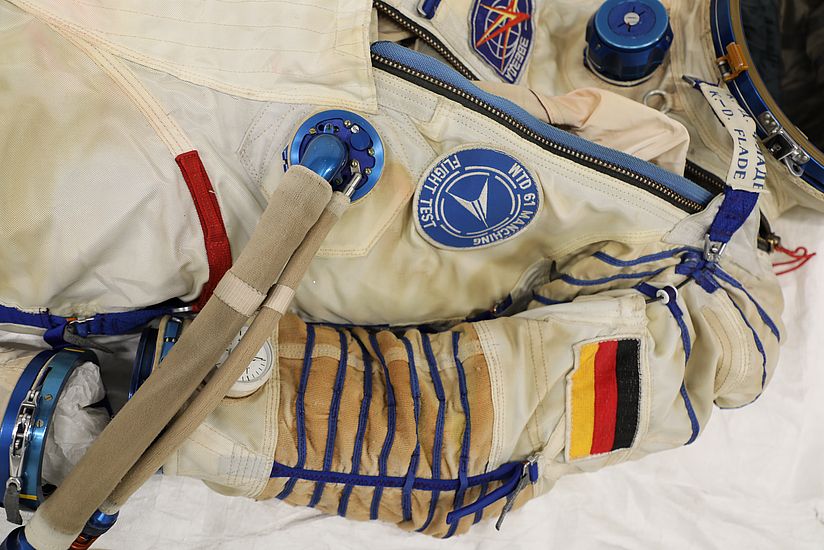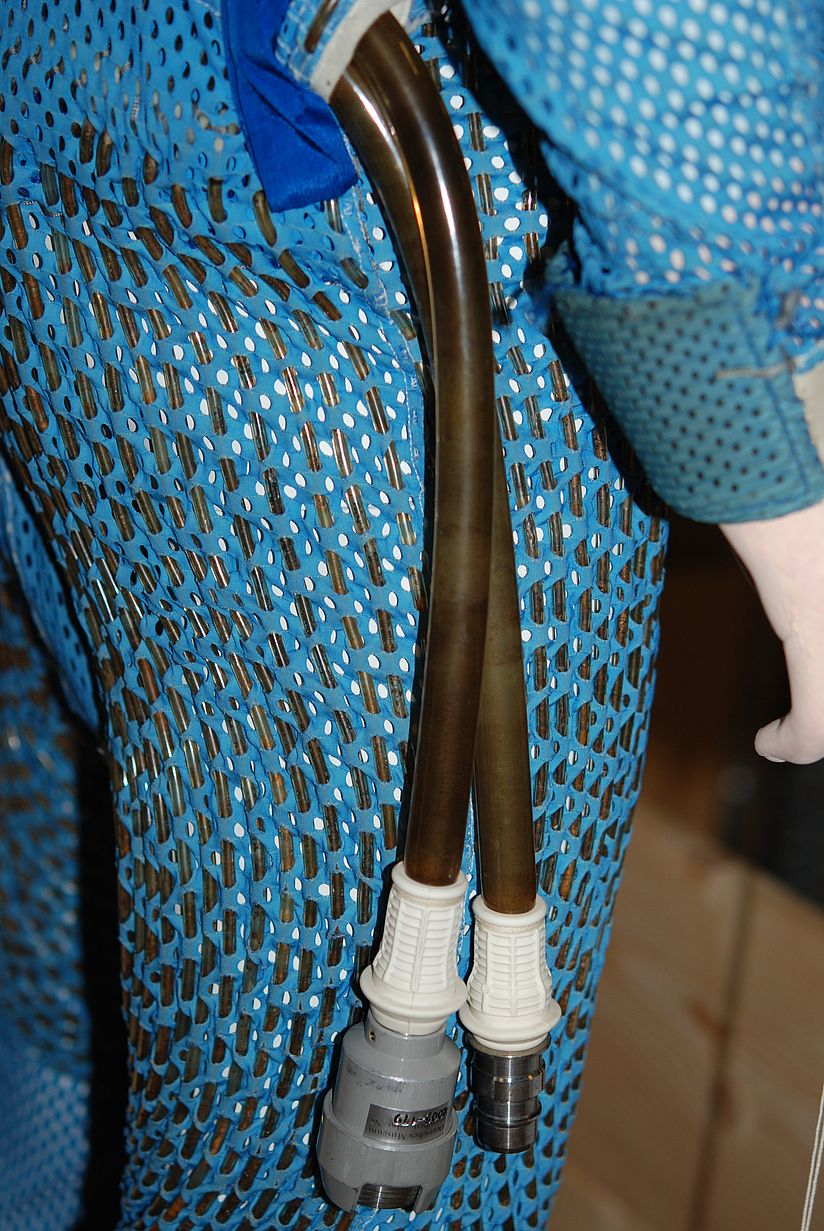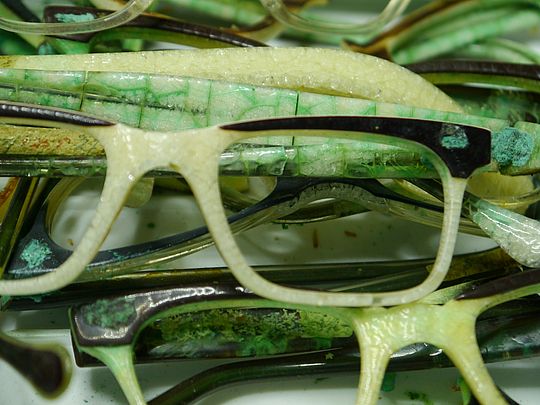![[Translate to English:] [Translate to English:]](/assets/_processed_/7/7/csm_Acrylglas_Dachelement_Inv_Nr_2768_aaa44577a1.jpg)

Conservator Charlotte Holzer taking material samples from the Sokol-KV-2 spacesuit Photo: Deutsches Museum | Christian Illing
Material and Production
Multi-layered & functional
Spacesuits have the function of protecting astronauts in a hostile atmosphere. Textiles such as coated fabrics or flexible knitted fabrics form the shell and structure of the technical equipment. In the museum, the complex exhibits themselves must be protected from damaging influences.
Content
Multi-layered & functional: Methods to preserve space suits
- Material and Production
- Conservation science
Edited by
Dr. Charlotte Holzer
Wissenschaftliche MitarbeiterinRestaurierung und Ausstellungstechnik, Ausstellungsprojekt Historische Luftfahrt, Schiffe und Meer
Dr. Marisa Pamplona Bartsch
Leitung Abteilung Konservierungswissenschaft
Dr. Robert Kluge
Head of Flugwerft Schleißheim (acting) and curator for aviation after 1945Aviation Department
Project description
The shelf life of spacesuits is limited to a few months to years, depending on the application and maintenance requirements. In the museum, on the other hand, exhibits should be preserved for several generations in order to learn about them and the people of the past. In 2018/19, aging phenomena in the material of the Russian pressure suit Sokol-KV-2 and damage caused by external influences were analysed. Now it is a matter of implementing and monitoring the recommended measures for preventive conservation.

Discolouration from orange to brown on the originally bright white spacesuit Sokol-KV-2 (23.5.2019) Photo: Deutsches Museum | Charlotte Holzer

Corrosion on the zipper and discolouration of the adhesive on the pilot’s suit Mark IV (10.4.2019) Photo: Deutsches Museum | Charlotte Holzer
Preserving objects in the exhibition
Damage factors for space and pilot suits are light, humidity, increased temperature and pollutants from synthetic material in the exhibits or the showcase. The space exhibition is designed as a dark room without daylight, and the spectrum of LED lights does not contain any UV. The showcase for the suits is conditioned to a relative humidity of 30–40% by means of passive air conditioning and the temperature is regulated via the exhibition space. Fans ensure air circulation in the showcase so that potentially polluted air flows over activated carbon fabric in the air-conditioning compartments. Unsuitable materials for the figures are replaced by new ones and their posture is improved in the process.Damage factors for space and pilot suits are light, humidity, increased temperature and pollutants from synthetic material in the exhibits or the showcase. The space exhibition is designed as a dark room without daylight, and the spectrum of LED lights does not contain any UV. The showcase for the suits is conditioned to a relative humidity of 30–40% by means of passive air conditioning and the temperature is regulated via the exhibition space. Fans ensure air circulation in the showcase so that potentially polluted air flows over activated carbon fabric in the air-conditioning compartments. Unsuitable materials for the figures are replaced by new ones and their posture is improved in the process.

Heavily yellowed tubing of the water-cooled inner suit of the EVA space suit Orlan D (10.4.2019) Photo: Deutsches Museum | Charlotte Holzer
Methods for reviewing the measures
When illuminating, conservators use a lux meter to check the recommended 50 lx light intensity. The constant recording of climate data and pollutant gas monitoring are the basis for decision-making for further improving the exhibition showcase. Changes to the exhibits are documented by means of photography as well as colour measurement and the airtightness of the showcase is assessed.
Foto Gallery
Events
Lectures
- Charlotte Holzer, Der Sokol-KV-2-Raumanzug von Klaus-Dietrich Flade. Konservatorische Empfehlungen zur Ausstellung „Raumfahrt“, Arbeitskreis Forschung, Deutsches Museum, München, 25. Juni 2019
Publications
Charlotte Holzer, Marisa Pamplona, Anna Micheluz, Poster: Why does it change its color? Damage analysis on a Russian spacesuit Sokol KV-2, Future Talks 2019, Neue Sammlung, München 11. November 2019
Related links
Cooperation partners
[Translate to English:]
- National Air and Space Museum, Smithsonian Institution, Washington, D.C.
- Lehrstuhl für zerstörungsfreie Prüfung, Technische Universität München
- Fraunhofer-Entwicklungszentrum Röntgentechnik


![[Translate to English:] [Translate to English:]](/assets/_processed_/e/4/csm_Play_YagouRelaunch_Bild1_bf60a9b213.jpg)


![[Translate to English:] [Translate to English:]](/assets/_processed_/6/f/csm_210528_2235_Lilienthal-Gleiter_47d1b47d12.jpg)